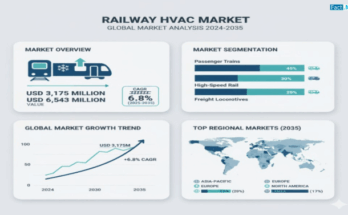The global outdoor warning sirens market is witnessing steady expansion, driven by growing investments in emergency management infrastructure, the increasing frequency of natural disasters, and heightened public awareness of disaster preparedness. According to a recent report by Fact.MR, the market is projected to grow from USD 169.7 million in 2024 to USD 280.2 million by 2035, expanding at a CAGR of 4.8% during the forecast period from 2025 to 2035.
Outdoor warning sirens play a vital role in alerting communities about imminent threats such as tornadoes, floods, wildfires, and industrial accidents. The increasing need for reliable, high-decibel alerting systems, coupled with advancements in solar-powered and networked siren technologies, is driving widespread adoption across municipalities and industrial zones.
Strategic Market Drivers
- Increasing Frequency of Natural Disasters
The growing incidence of severe weather events, including hurricanes, floods, and wildfires, has accelerated the deployment of outdoor warning systems. Governments and municipalities are prioritizing investment in resilient, energy-efficient, and network-integrated sirens to improve disaster response and minimize casualties. In disaster-prone regions such as North America and parts of Asia-Pacific, local authorities are expanding siren networks as part of comprehensive emergency communication frameworks.
- Expansion of Urban and Industrial Infrastructure
Rapid urbanization and industrialization are key contributors to market growth. Cities are investing in integrated emergency systems to safeguard larger populations, while industrial facilities such as chemical plants, power stations, and refineries rely on sirens for on-site safety and hazard communication. Integration with IoT and centralized control systems enables faster, more coordinated emergency alerts.
- Technological Advancements and Renewable Energy Integration
The shift toward solar-powered and wirelessly connected sirens is transforming the industry landscape. Energy-efficient models reduce maintenance costs and enhance reliability during power outages. Additionally, the inclusion of two-way communication, remote diagnostics, and real-time monitoring improves operational efficiency and system resilience.
Regional Growth Highlights
North America: Leader in Emergency Infrastructure Modernization
North America continues to dominate the outdoor warning sirens market, driven by extensive federal and state-level funding for emergency preparedness. The United States, in particular, has implemented large-scale replacement and expansion programs to upgrade legacy systems with solar and wireless-enabled sirens. Partnerships between government bodies and private manufacturers are strengthening the market ecosystem.
Europe: Adoption Driven by Safety Regulations
Europe’s stringent safety regulations and disaster management mandates are fostering steady market growth. Countries such as Germany, France, and the U.K. are investing in siren modernization programs, emphasizing sustainable and low-emission technologies. The European Union’s initiatives on climate adaptation and urban resilience are further promoting the deployment of advanced outdoor warning systems.
Asia-Pacific: Rapid Urbanization and Disaster Risk Management
Asia-Pacific represents a rapidly growing market due to frequent natural disasters and expanding urban populations. Nations like Japan, India, and Indonesia are actively investing in large-scale emergency warning networks. The growing collaboration between local governments and technology providers is accelerating the deployment of durable, high-output sirens designed for extreme environmental conditions.
Latin America, Middle East & Africa: Emerging Demand
Emerging economies are increasingly recognizing the importance of public safety infrastructure. In regions with rising urban density and industrial expansion, the demand for cost-effective, easy-to-deploy siren systems is gaining momentum. Governments are partnering with international aid organizations to implement localized warning systems tailored for flood-prone and seismic regions.
Browse Full Report: https://www.factmr.com/report/1435/outdoor-warning-sirens-market
Competitive Analysis
The global outdoor warning sirens market is moderately consolidated, with key players focusing on technology upgrades, partnerships with local authorities, and sustainable manufacturing practices. Leading manufacturers are investing in solar and digital communication technologies to enhance product performance and adaptability.
Key players in the outdoor warning sirens industry include:
• Federal Signal
• Whelen Engineering Company
• HORMANN Warnsysteme
• Sentry Siren Inc.
• American Signal Corporation
• Edwards Signaling
• ORSON France
These companies are strengthening their positions through regional expansion, collaborative R&D, and the introduction of intelligent and eco-friendly siren systems designed for smart cities and industrial safety networks.
Recent Developments
- April 2024 – ATI Systems introduced an upgraded modular siren platform featuring real-time remote diagnostics and two-way communication. This innovation allows for remote configuration of alerts and system health monitoring. The system was deployed across several high-threat municipalities in Texas and Florida, increasing ATI’s municipal siren business by an estimated 8% year-over-year.
- December 2023 – The City of Edmonton commissioned fifteen new solar-powered sirens manufactured by Sentry Siren Inc. to strengthen flood and wildfire preparedness. This carbon-neutral initiative, part of a larger climate resilience project, marks Sentry’s largest deployment in a Canadian urban center to date.
- June 2023 – Whelen Engineering Company launched a new series of solar-powered sirens, capturing approximately 12% of the market share due to their eco-friendly design. The company is forming strategic alliances with government agencies and emergency management organizations to expand its market presence in North America.
Future Outlook: Advancing Toward Smarter, Greener Alert Systems
The future of the outdoor warning sirens market lies in the convergence of sustainability, digital connectivity, and automation. The integration of IoT, AI-based monitoring, and renewable energy technologies will redefine how emergency alerts are issued and managed.
With growing emphasis on public safety, environmental sustainability, and resilient infrastructure, the market is poised for robust growth over the next decade. Companies that prioritize technological innovation, energy efficiency, and strategic collaboration will lead the next generation of intelligent outdoor warning systems — ensuring communities are safer, smarter, and better prepared for emergencies.



